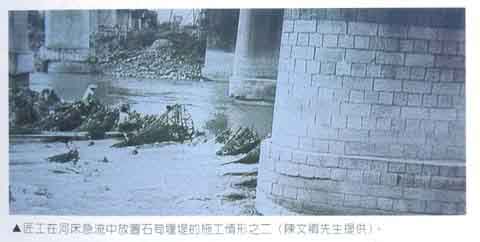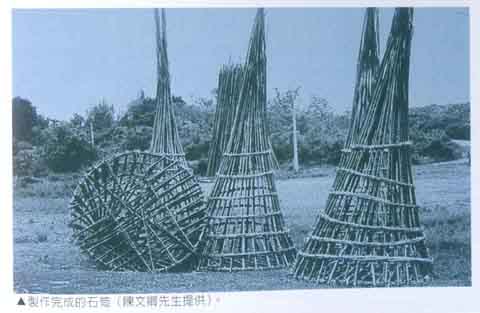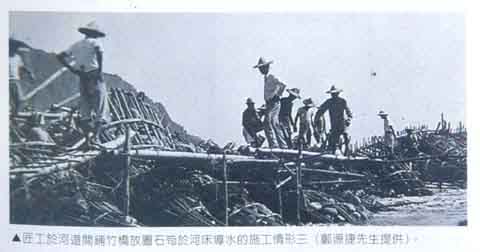
Your Site﹥﹥homepage﹥Explore the Babao Canal﹥Water control methods
| Text guide | Audio and visual guide | Water control methods | Go Back in Time |
Water control methods
The water control method transmitted by “Lin Siansheng” to Shih-bang Shih is called “soil dam method.” The name of the object is “shih-gou” (gou, Taiwanese pronunciation is ko5), and is a water-guiding tool. The people of Ershui also call it “lang-a-ko” or “dam cage,” and was the method taught by “Lin Siansheng” to Shih-bang Shih on how to guide water into the canal manually.
1. Origins
Invention and usage of dam cage (shih-gou) was from the source of Babao Canal (near Mingchu Bridge on the boundary of Mingjian Township and Chushan Township of Nantou County in present-day Jhuoshuei River midstream), to resolve the problem of variability of water level from wet to dry seasons. During the spring and summer wet season, rising waters and changes in the river route often caused irrigation problems for the downstream plains. However, there is little rain in the fall and winter, thus it is necessary to increase the water conveyance speed and volume for agricultural use. Thus, this sort of method in artificial changing and damming the water flow was created.
2. Materials used
This method primarily uses bamboo and rattan, wooden boards or bamboo, and rocks. The rattan is first used to tie the wood or bamboo, woven into an item broad on the top and narrow on the bottom like a bamboo shoot; it is commonly known as a “gou.” Then, when it is being used, they are placed from upstream to downstream, connected into a corral, and stones of different sizes are used to fill the dam cage to block the river water; thus this tool is called the “shih-gou”.
3. Type
Shih-gou can be divided into “pyramid gou” and “conical gou” based on their shape.
(1) Pyramid gou-head are 12 chi. These are larger and can bear more force, and are made with logs.
(2) Conical gou-head are 7 chi wide, about 6 chi tall, and can be adjusted according to need. However, the maximum height is 12 chi. Due to the small size, Makino bamboo is used for conical gou.
Tying shih-gou usually requires skilled personnel, or tying masters. Each gou usually requires a master and at least 2 laborers according to its size and type.
4. Commissioning procedures
At the end of each year, the Irrigation Association publicly solicits bids for the next year’s water conveyance construction. The bid winner must then accept direction from the Irrigation Association for construction. The bid winner for the year uses buffalo carts to transport and accumulate the procured bamboo (for constructing temporary bridges, usually Giant Taiwanese Bamboo), logs, Makino bamboo, rattan (for tying the gou materials), straw (to fill the space between stones to reduce leakage, which affect flow speed and volume). The company that wins the bid also needs to make several gou in order to prepare for emergencies before they occur.
In addition, the construction company needs to contract with construction masters in Ershui Township or nearby Xizhou Xiashuipu (Dazhuang), such as: gou-tying masters, water placement masters, crane masters, to send them gifts (deposit money) for making contracts and to have a grasp of the labor, to prevent a lack of labor when needed. The small laborers and stone cutters are temporarily recruited by the masters on their own. After everything has been prepared, they await the construction notification and can start the manufacturing of shih-gou.
5. Usage time and conditions
The time for using shih-gou is dependent upon whether it is for changing the waterway or for blocking water flow. During the dry season each fall and winter (October to the following May), there is little rainfall, and the rivers run dry. In order to avoid losses for conveying water and to increase the speed for water conveyance, they are used when it is necessary to lengthen the water conveyance canal.
Also, in the wet seasons of spring and summer (May to September), the temporary water-blocking dam cages on the riverbeds are often destroyed by floods, making the water flow change direction in an instant. At this point, the water channel has to be modified immediately, using new channels to convey water into the canal. It is necessary to use shih-gou to change water course or block water flow.
Usually, mainly the pyramid gou are used while the conical gou play a supporting role. The conical gou are placed between pyramid gou to fill the space and make up for insufficiencies in the function of pyramid gou. The winch is used to bring water down the gou, is an important tool for controlling the direction of the gou, and is an indispensable tool when workers set down the gou in the rainy season.
During the dry season shih-gou can be placed in any direction without regard to up- or downstream. Since this is easy, a hundred of them can be placed within a day. However, during the wet season, shih-gou must be placed starting in the downstream to the upstream. When placing shih-gou, the front side of the gou-head needs 5-6 people, and 2 people on the gou-tail, and one person each on the sides of the gou. At least 10 to 15 people are required to set up a shih-gou. At the same time, it is necessary for people who set up the gou to be familiar with water. Experienced placement masters stand by for guidance, and supervise placement along with hydraulics personnel. During the wet season, since it is difficult to place them in the water, usually fewer than 10 are placed in a day. The stone-filling masters are responsible for filling the gou with stones.
 |
|||
|
Completed shih-gou dam (provided by Tsung-pao Lai)
|
|||
 |
 |
||
|
Laborers placing the shih-gou in the rapids on the river bed, 1 (Provided by Wen-ching Chen) The secret of the dam soil method is to use shih-gou to block the river water. |
Laborers placing the shih-gou in the rapids on the river bed, 2 (Provided by Wen-ching Chen)The shih-gou placed by laborers in the rapid-flowing river bed. | ||
 |
 |
||
| Laborers making shih-gou. | Completed shih-gou | ||
 |
 |
||
| Laborers laying bamboo bridge on the river bed for placement of shih-gou. | Jhuoshuei River shih-gou dams block the water. | ||